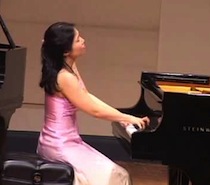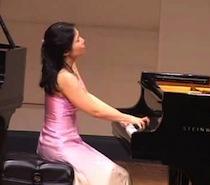For chamber music aficionados, Music@Menlo remains one of the more attractive events on the summer music calendar. The annual festival and institute in the Silicon Valley takes a rare approach to programming: Where other presenters are wont to gather repertoire under no particular organizing principle, Menlo founders and Co-Artistic Directors David Finckel and Wu Han structure their programs around a single composer, with an eye (and ear) to connections past, present, and future.
At this year’s festival — Music@Menlo’s ninth — the composer is Brahms, and, in addition to performances of his own works, each program explores his forebears and followers, reflecting on his compositional influences and drawing an intriguing through-line to the composers he influenced in turn. Call it contextualizing on a grand musical scale.
Tuesday night’s concert in the Center for the Performing Arts at Menlo-Atherton High School was named “Brahms the Prismatic,” and with the exception of Bach’s Cello Suite No. 2 in D Minor, BWV 1008, the bulk of the programming was devoted to the composers who followed in Brahms’ footsteps. Where else could you hear, contained in a single program, Rachmaninov’s Vocalise, Op. 34, No. 14; Schoenberg’s Phantasy for Violin and Piano, Op. 47; and John Harbison’s Piano Quintet? With Brahms’ Sonata for Two Pianos in F Minor, Op. 34b, serving as connective tissue, this was a program designed to cover distance.
An excellent lineup of musicians made it a rewarding journey, with the performances in Menlo-Atherton’s congenial, 492-seat hall ranging from intriguing to sensational. (Additional programs, through Aug. 13, are devoted to lieder, gypsy music, and string quartets, with Carte Blanche recitals, Prelude performances, and young-artist concerts rounding out the calendar.)
These performances certainly invited listeners to make their own connections from Brahms to his program mates, from the formal clarity of Bach’s Cello Suite and the insistent repeated motifs of Schoenberg’s Phantasy to the block chords and serene string writing of Harbison’s Piano Quintet.
All for a Vibrant Artist

Harbison’s Quintet emerged as both the program’s surprise entry and its thrilling centerpiece. Composed in five movements, the work was dedicated to painter Georgia O’Keeffe and premiered in 1981 at the Santa Fe Chamber Music Festival. From the opening Overtura to the Elegia movement that concludes the work 25 minutes later, Harbison’s score is vibrant and energetic; the inner movements include a nimble Capriccio, a restless Intermezzo, and a fiendishly acerbic Burletta.
The writing has a distinctly American sensibility, but Harbison’s regard for Brahmsian form is unmistakable. Pianist Lucille Chung, violinists Jorja Fleezanis and Ian Swensen, violist Yura Lee, and cellist Laurence Lesser gave it a dynamic, go-for-broke performance.
The program began with Bach’s Cello Suite in an earnest, if unremarkable, reading by Lesser. Chung joined Swensen next, in a crisp, intricate, and elegantly precise traversal of Schoenberg’s jittery Phantasy. Rachmaninov’s Vocalise received a penetrating, notably clear-eyed performance from Swensen and the gifted young Italian pianist Alessio Bax.
And then, after intermission, there was Brahms’ Piano Sonata. Chung, a muscular, extroverted player, paired nicely with Bax’s cool, slightly restrained pianism. The results sounded wonderfully spontaneous — alternately stately, playful, reflective and explosive. In this 1864 score (originally conceived as a string quartet and rearranged as a sonata for two pianos before assuming its final form for piano and string quartet), Brahms created a work of tremendous range and power, one that summoned the enveloping sound world of his later Piano Quintet. This wasn’t a flawless performance, yet it was one to leave you wondering how such a quintessentially Romantic work could sound so modern.

